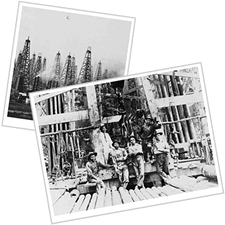Black Gold: Texas Oil
The discovery and development of Texas oil and natural gas fields was and is a continuing  economic boom for Texas. It allowed economic diversification, establishing a Texas industrial base with the construction of oil fields, pipelines, refineries, railroads, port facilities, and their attendant support industries. The Texas “oil boom” also wove itself indelibly into the fabric of Texas culture and myth.
economic boom for Texas. It allowed economic diversification, establishing a Texas industrial base with the construction of oil fields, pipelines, refineries, railroads, port facilities, and their attendant support industries. The Texas “oil boom” also wove itself indelibly into the fabric of Texas culture and myth.
Oil drilling could be dangerous work. However, the risk was balanced by the potential payout, especially for wildcatters if they could find a new oil field.
In 1900, Texas oil production was only 836,039 barrels. The oil discovery which initiated the Texas oil boom and transformed Texas into an industrial power was Spindletop. Captain Lucas F. Lucas, a Louisiana mining engineer and oil prospector, after several failed attempts in an area of the upper Gulf Coast near Beaumont, drilled the successful discovery well on January 10th, 1901. The Lucas No. 1 well was exceptionally productive at an average of 75,000 barrels of oil a day, heralding a significant oil field. The ensuing flood of oilmen and speculators resulted in a massive number of new wells and discovery of other fields. The Spindletop well, Lucas No. 1, alone produced 17.5 million barrels of oil in 1902 and the Beaumont oil field quickly expanded to over 500 wells on 144 acres! Of course the oil boom necessitated creation of massive service and support industries, such as: refineries, pipeline and drill manufactures, lumber, oil equipment, merchants, saloons, general stores, housing, hucksters, and speculators. These oil wells, refiners, pipelines, and ports became the foundation of Texas’s industrial transformation.
